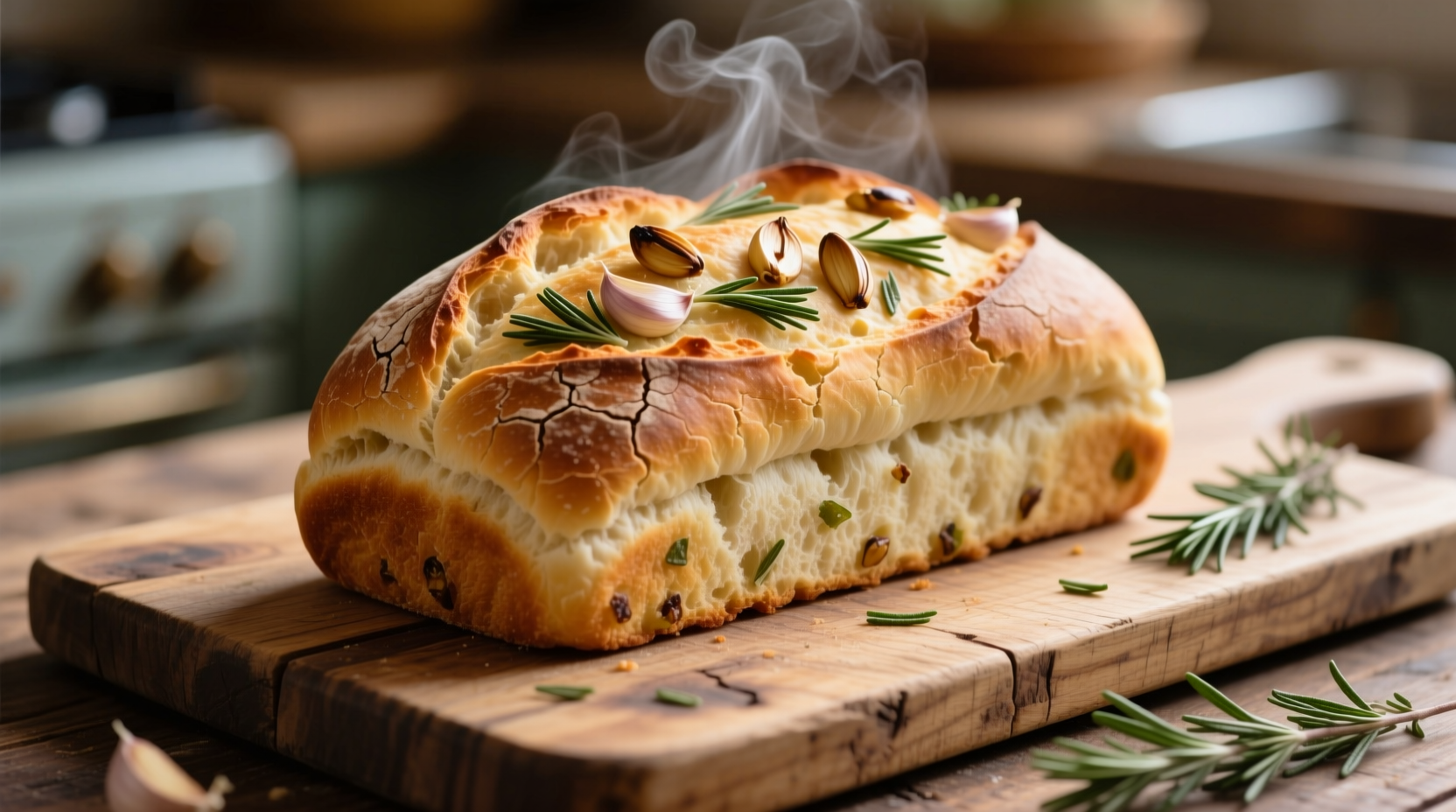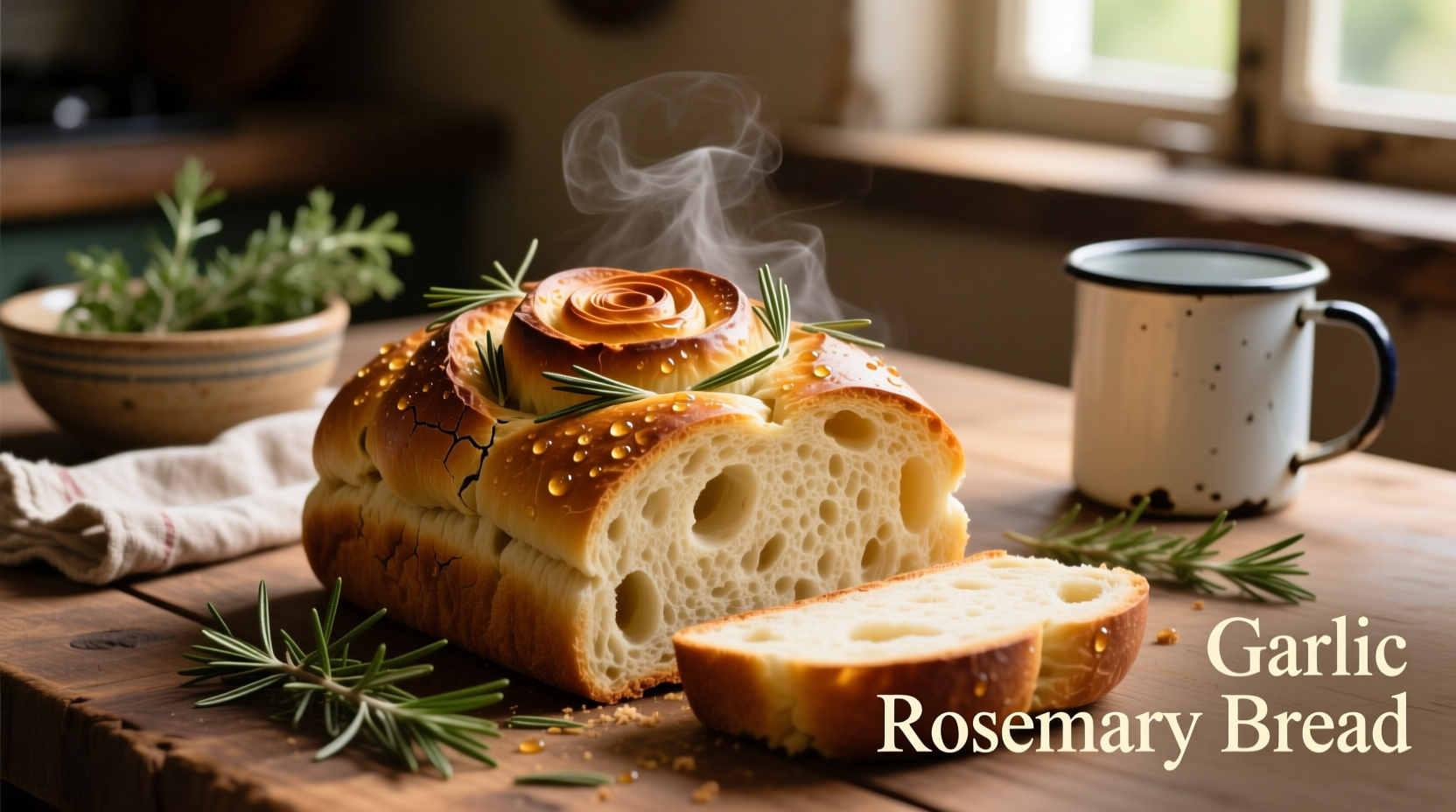Garlic rosemary bread combines aromatic fresh rosemary, roasted garlic, and perfectly baked artisan bread for a flavorful side dish that elevates any meal. This classic European-inspired bread requires just 6 simple ingredients, 3 hours of hands-off preparation time, and delivers exceptional flavor through proper fermentation and baking techniques that home bakers can master with our step-by-step guide.
Nothing transforms a simple meal like the aroma of freshly baked garlic rosemary bread filling your kitchen. This beloved bread combines two of the most complementary flavors in culinary history—garlic's pungent depth and rosemary's pine-like fragrance—to create a versatile side that pairs beautifully with pasta, soups, salads, and grilled meats. While many settle for store-bought versions loaded with preservatives, crafting authentic garlic rosemary bread at home allows you to control ingredient quality and achieve superior texture and flavor.
The Essential Ingredients for Perfect Garlic Rosemary Bread
Quality ingredients form the foundation of exceptional garlic rosemary bread. Unlike commercial versions that use garlic powder and artificial flavors, authentic preparation requires fresh components that work in harmony during the baking process.
| Ingredient | Quality Requirement | Why It Matters |
|---|---|---|
| Bread Flour | 11-12% protein content | Creates optimal gluten structure for proper rise and chew |
| Fresh Rosemary | Bright green, fragrant needles | Dried rosemary lacks complexity and can become bitter when baked |
| Garlic | Fresh, firm bulbs without sprouting | Roasting transforms harsh raw garlic into sweet, mellow flavor |
| Water | Filtered, room temperature | Chlorine in tap water can inhibit yeast activity |
Step-by-Step Preparation Guide
Creating exceptional garlic rosemary bread follows a straightforward process when you understand the critical stages that develop flavor and texture.
1. Roasting the Garlic (30 minutes)
Begin by roasting whole garlic heads to transform their sharp bite into sweet, caramelized complexity. Cut 1-1.5 inches off the top of 2-3 garlic heads, drizzle with olive oil, wrap in foil, and roast at 400°F (200°C) for 30 minutes until soft and golden. This crucial step prevents the harsh garlic flavor that ruins many homemade versions.
2. Mixing and First Fermentation (2 hours)
Combine 500g bread flour, 350ml water, 7g active dry yeast, 10g salt, the roasted garlic (squeezed from cloves), and 2 tablespoons finely chopped fresh rosemary. Mix until just combined—overmixing develops too much gluten at this stage. Cover and let rest for 30 minutes, then perform stretch-and-fold techniques every 30 minutes for 2 hours. This develops structure without excessive kneading.
3. Shaping and Final Proof (1 hour)
After the dough has doubled, gently shape into a round boule or oval bâtard. Place in a floured banneton or bowl lined with a floured kitchen towel. Cover and proof at room temperature for 1 hour, or refrigerate overnight for more complex flavor development—a technique professional bakers use to enhance sourdough characteristics even in yeast-leavened breads.
4. Baking for Perfect Crust and Crumb (35-40 minutes)
Preheat your oven to 450°F (230°C) with a Dutch oven inside. Carefully transfer the dough to the hot Dutch oven, score the top with a sharp knife, and bake covered for 20 minutes. Remove the lid and continue baking for 15-20 minutes until deeply golden brown. The internal temperature should reach 205-210°F (96-99°C). This steam-baking method creates professional-quality crust at home.
Avoid These Common Garlic Rosemary Bread Mistakes
Even experienced home bakers encounter pitfalls when making garlic rosemary bread. Understanding these common errors ensures success every time:
- Using dried rosemary instead of fresh—Dried rosemary becomes woody and bitter when baked, while fresh rosemary releases aromatic oils that distribute evenly throughout the dough
- Adding garlic too early in the process—Raw garlic inhibits yeast activity; always roast garlic first or add it after the initial fermentation
- Over-handling the dough during shaping—Excessive handling degasses the dough, resulting in dense bread rather than the open crumb structure characteristic of artisan bread
- Baking at too low a temperature—Garlic rosemary bread requires high heat (450°F/230°C minimum) to properly set the crust before the interior over-expands
Historical Context: Garlic and Rosemary in Bread Making
The pairing of garlic and rosemary in bread has deep historical roots that explain their perfect compatibility. Understanding this evolution reveals why these ingredients work so well together:
| Time Period | Garlic Usage | Rosemary Usage |
|---|---|---|
| Ancient Rome (1st-5th century CE) | Added to bread dough for preservation and flavor; considered medicinal | Used as a symbol of remembrance; added to breads for special occasions |
| Medieval Europe (5th-15th century) | Common in peasant breads; believed to ward off illness | Added to bread dough for its preservative qualities and distinctive flavor |
| Renaissance (14th-17th century) | Featured in cookbooks like Platina's De honesta voluptate (1474) | Recognized for enhancing memory; commonly paired with garlic in regional breads |
| Modern Era (20th century-present) | Commercial versions emerged with artificial flavors; artisanal revival in 1980s | Recognized for antioxidant properties; fresh rosemary preferred in quality breads |
According to culinary historians at the Oxford Symposium on Food and Cookery, the Mediterranean tradition of combining garlic and rosemary in bread dates back to at least the 13th century, when both ingredients were valued for their preservative qualities in addition to flavor. The Bread Bakers Guild of America notes that traditional Tuscan and Provençal breads often featured these ingredients, with regional variations based on local garlic varieties and rosemary subspecies.
Serving and Storage Recommendations
Proper handling after baking ensures your garlic rosemary bread maintains optimal texture and flavor:
- Resting period: Allow bread to cool completely (1-2 hours) before slicing to prevent gummy texture
- Serving temperature: Warm slices in a 300°F (150°C) oven for 5 minutes for best flavor release
- Storage: Keep in a paper bag at room temperature for 2-3 days; avoid plastic which traps moisture and softens crust
- Freezing: Slice completely cooled bread, wrap in parchment paper, then place in freezer bag for up to 3 months
According to FDA food safety guidelines, homemade bread without preservatives should not be stored at room temperature beyond 4 days. For longer storage, freezing is recommended to maintain quality and prevent mold growth. Never store bread in the refrigerator, as the cool, dry environment accelerates staling through retrogradation of starch molecules.
Popular Variations to Explore
Once you've mastered the classic version, these authentic variations expand your garlic rosemary bread repertoire:
- Cheese-infused: Add 100g finely grated Pecorino Romano during the final fold for savory depth
- Olive oil variation: Substitute 50ml water with high-quality extra virgin olive oil for richer crumb
- Whole grain version: Replace 25% of bread flour with whole wheat flour for nuttier flavor
- Lemon zest addition: Incorporate 1 tablespoon lemon zest with the rosemary for bright contrast
Professional bakers at the Culinary Institute of America recommend starting with the classic version before experimenting with variations. Their research shows that the fundamental technique—particularly proper fermentation and baking temperature—matters more than additional ingredients for achieving exceptional results.

Perfect Pairings for Garlic Rosemary Bread
This versatile bread complements a wide range of dishes when served at the right temperature:
- With soups and stews: Serve slightly warmed alongside tomato basil soup or beef stew
- As bruschetta base: Slice thinly, toast, and top with fresh tomatoes and balsamic reduction
- With cheese boards: Pairs exceptionally well with aged cheddar, manchego, and soft goat cheese
- As sandwich bread: Excellent for paninis with roasted vegetables and pesto
Food pairing experts at the Institute of Culinary Education note that the pine-like notes in rosemary naturally complement earthy and roasted flavors, while garlic enhances umami-rich dishes. This explains why garlic rosemary bread works particularly well with tomato-based dishes, grilled meats, and mushroom preparations.











 浙公网安备
33010002000092号
浙公网安备
33010002000092号 浙B2-20120091-4
浙B2-20120091-4